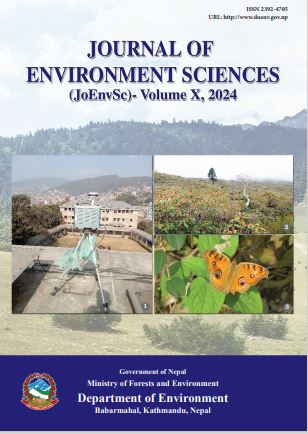Effects of Grazing in Natural Regeneration at Tree Line region in Lamtang National Park, Nepal
DOI:
https://doi.org/10.3126/jes.v10i1.66974Keywords:
Regression Analysis, Seedling sapling ratio, Seedling density, Seedling health, Soil parametersAbstract
Livestock grazing in the form of transhumance activities is common practices in the mountainous region of Nepal. Such grazing activities can impact on natural regeneration of tree species. Being grazing practices as major occupation, not enough research has been carried out on impacts of grazing and management of grazing area in Nepal. This study was conducted with an aim to assess the effects of grazing in natural regeneration in tree line region of Lamtang National Park (LNP). Transect method was carried out for study after identifying different grazing intensities in field. Data were analyzed to study phyto-sociological characteristic (species richness, Shannon-Wiener Diversity Index and density) of vegetation, health of seeding, soil characteristic and disturbance index in grazing region. ANOVA, Kruskal-Wallis test and linear regression were performed to elucidate the relationship between vegetation attributes and grazing intensities. The relationship was further analyzed using post-hoc test i.e., Tukey post hoc test for normal data and Dunn test for skewed data. The result shows that Abies spectabilis has set the upper altitudinal limit in all sampling areas i.e., ungrazed, least grazed and moderately grazed area at 3803 m, 3827 m and 3860 m respectively. Moderately grazed area had the higher tree richness, diversity, density and natural regeneration. The density of seedlings was also higher in moderately grazed area. Only 18.3% of seedlings were found to be healthy in moderately grazed area which is comparatively lower than in ungrazed area (69.8%). Soil parameters such as Bulk density, Moisture content, pH and Nitrogen showed the variation with grazing intensities. The linear regression analysis showed the insignificant decrease (p=0.18) and insignificant increase (p=0.08) in seedling density with increase in disturbance score in ungrazed and least grazed area respectively. However, for the moderately grazed area, there is significant increase (p=0.02) in seedling density with increase in disturbance score. As moderate forest grazing helps to maintain the natural regeneration, grazing management is recommended in the higher Himalayan region.




